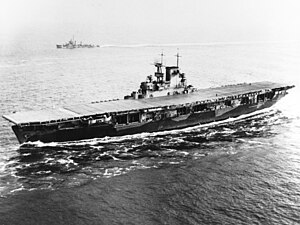Wasp-class aircraft carrier

USS Wasp entering Hampton Roads
|
|
| Class overview | |
|---|---|
| Name: | Wasp class |
| Operators: |
|
| Preceded by: | Yorktown class |
| Succeeded by: | Essex class |
| Built: | 1936–40 |
| In commission: | 1940–42 |
| Planned: | 1 |
| Completed: | 1 |
| Lost: | 1 |
| History | |
|
|
|
| Name: | Wasp |
| Namesake: | USS Wasp (1814) |
| Ordered: | 19 September 1935 |
| Builder: | Fore River Shipyard |
| Laid down: | 1 April 1936 |
| Launched: | 4 April 1939 |
| Sponsored by: | Mrs. Charles Edison |
| Commissioned: |
|
| Struck: | 15 September 1942 |
| Honors and awards: |
American Defense Service Medal ("A" device) / American Campaign Medal/European-African-Middle Eastern Campaign Medal (1 star) / Asiatic-Pacific Campaign Medal (1 star) / World War II Victory Medal |
| Fate: | Sunk by IJN I-19, 15 September 1942 |
| General characteristics | |
| Type: | Aircraft carrier |
| Displacement: |
|
| Length: | |
| Beam: |
|
| Draft: | 20 ft (6.1 m) |
| Installed power: | 70,000 shp (52,000 kW) |
| Propulsion: |
|
| Speed: | 29.5 kn (54.6 km/h; 33.9 mph) |
| Range: | 12,000 nmi (22,000 km; 14,000 mi) at 15 kn (28 km/h; 17 mph) |
| Complement: |
|
| Sensors and processing systems: |
CXAM-1 radar |
| Armament: |
|
| Armor: |
|
| Aircraft carried: | As built: Up to 100 |
| Aviation facilities: |
|
USS Wasp (CV-7) was a United States Navy aircraft carrier commissioned in 1940 and lost in action in 1942. She was the eighth ship named USS Wasp, and the sole ship of a class built to use up the remaining tonnage allowed to the U.S. for aircraft carriers under the treaties of the time. As a reduced-size version of the Yorktown-class aircraft carrier hull, Wasp was more vulnerable than other United States aircraft carriers available at the opening of hostilities. Wasp was initially employed in the Atlantic campaign, where Axis naval forces were perceived as less capable of inflicting decisive damage. After supporting the occupation of Iceland in 1941, Wasp joined the British Home Fleet in April 1942 and twice ferried British fighter aircraft to Malta. Wasp was then transferred to the Pacific in June 1942 to replace losses at the battles of Coral Sea and Midway. After supporting the invasion of Guadalcanal, Wasp was sunk by the Japanese submarine I-19 on 15 September 1942.
Wasp was a product of the Washington Naval Treaty. After the construction of the carriers Yorktown and Enterprise, the U.S. was still permitted 15,000 long tons (15,000 t) to build a carrier.
The Navy sought to squeeze a large air group onto a ship with nearly 25% less displacement than the Yorktown-class. In order to save weight and space, Wasp was constructed with low-power machinery (compare Wasp's 75,000 shp (56,000 kW) machinery with Yorktown's 120,000 shp (89,000 kW), Essex-class's 150,000 shp (110,000 kW), and the Independence-class's 100,000 shp (75,000 kW)).
...
Wikipedia
